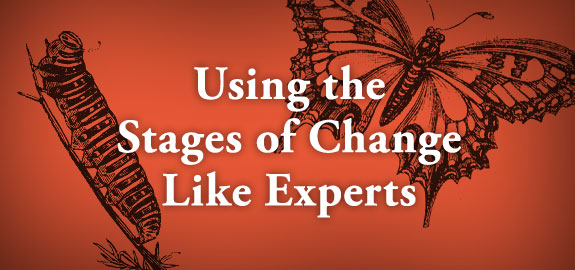Change is a process. In the Transtheoretical Model, a person’s stage of change is used to decide which strategies are most appropriate to promote or maintain change. This article provides practical tips and strategies to facilitate behavioral change.
“I enjoy smoking and I have no interest in quitting. It’s not a problem for me.”
“I know smoking is bad for me but it would be too hard to quit. It’s just not worth it.”
“I’m going to stop smoking on my birthday.”
“I haven’t smoked in a whole week!”
“I can’t believe I made it 6 months; it seems like only yesterday I had no interest in quitting.”
Change isn’t a one shot deal, it is a process that begins before the person considers changing and never ends. The Transtheoretical Model (TTM) assesses how ready a person is to engage in a new behavior. In the TTM there are five stages of change:
- Precontemplation: Not intending to change
- Contemplation: Thinking about making a change in the next 6 months
- Preparation: Thinking about changing in the next 30 days
- Action: Having made a change for less than 6 months
- Maintenance: Having made a change and kept it up for more than 6 months
A person’s stage predicts the most appropriate strategies to help them move forward with the change. The TTM is successfully applied to dozens of behaviors including smoking, alcohol and substance abuse, domestic violence, stress management, healthy eating, and exercise. The stages apply to everyone and every kind of change. Understanding the TTM can help PATH providers support consumers and better understand what is happening when people, including themselves, make changes in their lives.
The following tips for using the stages of change have been identified through collaboration with researchers at Pro-Change Behavior Systems, Inc.
Tips:
1. Recognize the signs of each stage of change. Each stage of change looks different.
People in Precontemplation do not believe that change is right for them. They are happy with the way things are and are haven’t considered changing because they don’t see a need for it.
Those in Contemplation may know the reasons for making a change, but believe the barriers outweigh the benefits. They are not ready to change.
In Preparation individuals intend to make a change in the near future. Planning a new years resolution often falls into this stage.
The difference between Action and Maintenance is how long a change has been implemented. A person who quits smoking a week ago (action) is in a very different position than someone who quits over six months ago (maintenance).
2. Understand that change often isn’t a linear process: People can be in the Contemplation stage for long periods of time. Also, people can move backward. Setbacks, such as those caused by a traumatic event, are often appropriate and can be a learning experience to think of different ways to handle the situation if it arises again. Never ridicule yourself or someone else for moving backward.
3. Change does not necessarily mean “action,” it means progress: People in Contemplation are much more likely to reach the action stage than those in Precontemplation. Likewise people in Preparation are much more likely to reach the action stage than those in Contemplation. While we often want to see the physical change, being increasingly ready to change is an accomplishment and three of the five stages take place before change is implemented in the action stage.
4. Focus on the advantages: In the early stages it is important to help people recognize the pros of changing without pressuring them. Some people exercise to lose weight. Others exercise to get stronger, de-stress, or be healthy for their children. Figuring out what motivates yourself or others can help the process move forward.
5. Understand the disadvantages: Common barriers are not having enough time, not knowing where to start, and not having enough money. While some barriers may never be eliminated, work to find solutions for as many barriers as possible and advantages that cancel out the barriers.
6. Increase Self-Efficacy: Confidence to make a change, maintain a change, and resist temptation to relapse increases with progression through the stages. The more you believe you can change, and keep it up, the more likely you are to be successful. Learning how others overcame barriers to change can also increase self-efficacy.
7. Set goals and action plans for later stages: Ensure sustainable success by making contingency plans to cope with difficult situations. For example, it’s more difficult to exercise and eat right during the holidays. Planning something active with your family or bringing your own healthy food to a party makes it easier to stick with your goals. And remember, if you don’t go to the gym or eat right for one day it doesn’t mean that you are a failure. There is always tomorrow.
The stages of change are part of the Transtheoretical Model (TTM). To find out more about the TTM and using the stages of change, check out Changing for James O. Prochaska. More information can be found on the University of Rhode Island website.
“Related Resources”:
Motivation for Change and Psychological Distress in Homeless Substance Abusers
Motivational Interviewing: Preparing People for Change (2nd Edition)
TIP 35: Enhancing Motivation for Change in Substance Abuse Treatment

